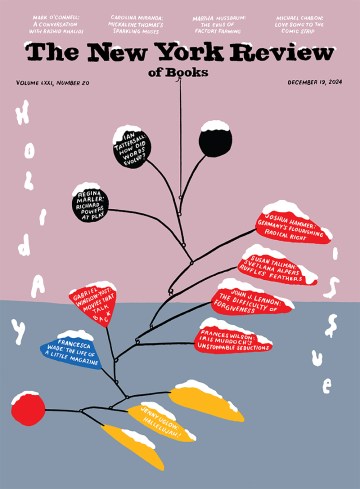Even in the darkest of times we have the right to expect some illumination… [which] may well come less from theories and concepts than from the uncertain, flickering, and often weak light that some men and women, in their lives and their works, will kindle under almost all circumstances and shed over the time span that was given them on earth.
—Hannah Arendt
I have been trying to imagine something of the flavor of the four and a half months that the composer Béla Bartók—age sixty-two, poor, and in failing health—spent in Asheville, North Carolina, during World War II. It was there, in the winter and spring of 1944, that he wrote his achingly beautiful Solo Sonata, by general agreement the greatest piece for unaccompanied violin since Bach’s Sonatas and Partitas, which date from the early eighteenth century. It was his last completed work.
Not Jewish himself but appalled by the rising and violent antisemitism in fascist Hungary (his opposition to which had cost him his Hungarian citizenship), Bartók had chosen self-exile in the United States, where he was less well known than in Europe, and where he had little means of supporting himself and his younger wife, Ditta. Three years after he emigrated his doctors reached a tentative—though mistaken—diagnosis of tuberculosis. With its mountain air, Asheville was considered an American Davos, a Magic Mountain for lung patients. Bartók would die of leukemia two years later.
*
On December 16, 1943, passengers on the southbound train from New York City saw a slight, delicate, white-haired man with intense blue eyes. Bartók, unaccompanied.
That same day, in a bid to put a quick end to the war, the British Royal Air Force sent 483 Lancaster heavy bombers and fifteen Mosquitoes on a raid on Berlin. The planes returned to England around 11 PM, with a loss of twenty-three Lancasters, only to find thick fog blanketing the landing area and visibility near zero. Crashes and bailouts ensued. Altogether, Bomber Command lost seventy aircraft and 327 men, the worst day of casualties in RAF history.
At Washington’s Union Station, passengers on Bartók’s train would have been awkwardly, and humiliatingly, reseated in the segregated Jim Crow cars of the Southern Railway.
I picture Bartók (with my imagination stoked by Carl Leafstedt’s detailed research) poring over transcriptions of Wallachian folk songs, some two thousand of which he had packed for the trip, as part of his magisterial and ongoing study of Romanian folk music.1 When your homeland is being hacked apart and its borders redrawn (the Hungarian town where Bartók was born is now part of Romania), this is one way to preserve it, song by song.
Beginning in 1906, Bartók, one of the founders of ethnomusicology, had recorded village singers in Romania, Hungary, and Slovakia, but also as far afield as Turkey and North Africa, relishing the extreme effects—quarter tones, “bent” notes, bizarre rhythms—that he later mined for his own music. Such research, he wrote in his autobiography, “freed me from the tyrannical rule of the major and minor keys.”
I picture the train, dubbed the “Asheville Special,” as it rattles farther into the night, taking a turn west at Greensboro (where my father, a ninety-eight-year-old refugee from Nazi Germany, lives) and on to Winston-Salem (where my Korean-born sister lives). And then the slow uphill climb to Asheville.
Under ordinary circumstances, Bartók, using funds supplied by the American Society of Composers, Authors, and Publishers, might have checked into the Grove Park Inn, a stone palace perched above the city. But the war had spread to Asheville. Requisitioned by the American military command, the Grove Park Inn served as a holding pen (or “alien internment center”) for Axis diplomats detained in the US. At Asheville’s Biltmore House, the most valuable treasures from the National Gallery in Washington—Vermeer, Rembrandt, Goya, some sixty paintings in all—were held in a secret “evacuation center” (actually the mansion’s reinforced music room) against a possible Axis attack on the capital.
Bartók moved into an upper-floor bedroom of the small Albemarle Inn, with a grand piano in the front hall. From his window he could see a stretch of woods rising toward the Blue Ridge. During the day, he classified folk songs and translated them into idiomatic English. He savored the erotic passages, “not disgusting urban army-filth but full of surprising ideas,” he told the Hungarian violinist Joseph Szigeti, and the curses, “quite Shakespearean in their fantasy.”
Reading Shakespeare was “his great joy” in Asheville, according to Arnold Dann, an English-born organist and choir director whom he had met through mutual friends. Leafstedt quotes at length from an interview with Dann recalling their meetings. One day, Dann remembered, Bartók knocked on his door to ask him about a passage in Richard III: “More pity that the ego should be mew’d, while tiresome buzzards prey at liberty.” Bartók demanded to know what “mew’d” meant.
Advertisement
The Belgian writer Maurice Maeterlinck turned up in Asheville and spent an evening with Bartók and Dann. Maeterlinck was the author of the Symbolist play from which Debussy’s opera Pelléas et Mélisande was adapted. “We just wanted him to talk about Pelléas, and especially his connection with Debussy,” Dann recalled, “but all he would talk about was bugs!… Bees, specifically”—the subject of one of Maeterlinck’s most popular books.
I like to believe that Bartók heard folk musicians in Asheville, a center then and now for traditional Appalachian music played on fiddle and banjo. Like Bartók roaming the Carpathians, John and Alan Lomax had been combing the region for songs. In our own time, the banjo-players Béla Fleck (named for the composer) and Abigail Washburn, and the mandolin virtuoso Chris Thile, have found a kindred spirit in Bartók, and performed arrangements of his music.
*
Bartók had composed nothing of his own since the extraordinary Sixth String Quartet at the start of the war. “My career as a composer is as much as finished,” he wrote in a letter late in 1942, before two commissions revived it. One was the popular Concerto for Orchestra, completed in October 1943. The other was the Solo Sonata. In November 1943 Bartók met Yehudi Menuhin, then in his late twenties, in New York. When Menuhin and a pianist friend played one of Bartók’s violin sonatas, Bartók said, “I did not think music could be played like that until long after the composer was dead.”
Knowing that Bartók was struggling financially, Menuhin suggested a commission—“It didn’t have to be anything large-scale,” he assured the composer—for solo violin. There was nothing small-scale about the piece that Bartók, a pianist by training, composed that spring in Asheville. “Little did I foresee that he would write me one of the masterpieces of all time,” Menuhin wrote in his autobiography. When the violinist first saw the austere, uncompromising piece, however, he thought it was “almost unplayable.”
The first movement, marked “Tempo di ciaconna”—an allusion to Bach’s famous Chaconne in his Second Partita—incorporates a fiendishly difficult volley of double, triple, and quadruple stops, basically chords performed across multiple strings. The second movement deploys four distinct voices in a jagged fugue, another tour de force. In these richly textured sections it is often hard to believe that only one violin is playing and not three or four. The last movement opens with a swirling buzzing in quarter tones, reminiscent of Maeterlinck’s bees, that morphs into a folk-dance motif.
And then there were the North Carolina birds. “The birds have become completely drunk with the spring,” Bartók wrote, “and are putting on concerts the like of which I’ve never heard.”
Bartók’s biographer David Cooper detects “a trace of birdsong” in “Melodia,” the haunting third movement of the Solo Sonata. Sitting by the window, the Blue Ridge marking the horizon, Bartók transcribed a pair of eighth notes in a descending fifth, B to F, then four sixteenth notes back on B. The rufous-sided towhee.
Menuhin described the isolation of Bartók’s life in America:
Exile made of him unaccommodated man, solitary, intense, requiring for material support only a bed, a table to write at and—but this might be considered a luxury—absolute quiet in which his inner concentration might bear fruit.
Bartók would have recognized Menuhin’s allusion to Lear addressing the Fool: “Thou art the thing itself: unaccommodated man is no more but such a poor bare, forked animal as thou art.”
Bartók died on September 26, 1945, three weeks after the war ended. At the time of his death, he was putting the finishing touches on his Third Piano Concerto, often called the Asheville Concerto, which incorporates the melody he had transcribed of the rufous-sided towhee.
“I am only sorry,” he told his doctor just before his death, “that I have to leave with my baggage full.”



